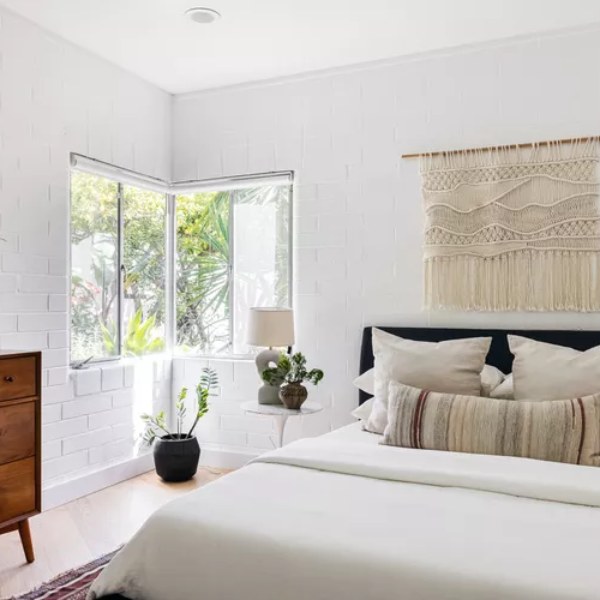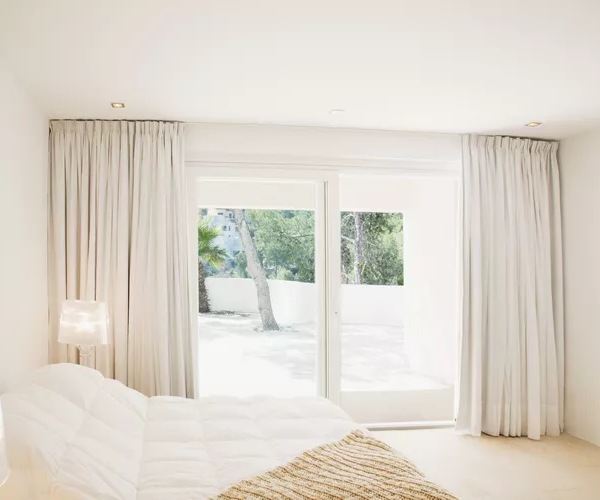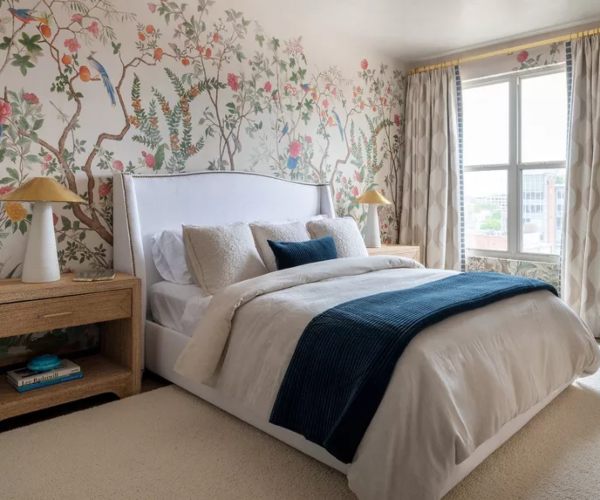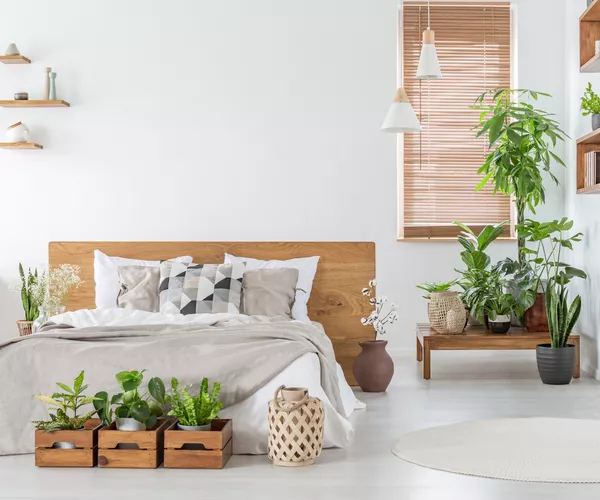Your bedroom is more than just a place to rest your head. A carefully crafted bedroom can create a serene environment that contributes to optimal sleep. And that’s beneficial because research has found a direct connection between consistent, high-quality sleep and improved cognitive function, good health, and overall well-being.
Interior designers take note of this. “The spaces we live in have a huge impact on our mental health and overall well-being,” says Andrew Pharis, architect and interior design expert at Vertical Arts Architecture. “When designed properly, a space can positively impact a person’s mood. On the other hand, a poorly designed space can leave someone feeling frustrated or even make them sick.”
We consulted design experts for their tips on turning your bedroom into a haven for sleep.
Take Away Clutter
A nice bedroom design always starts by being free from any mess. A cluttered bedroom can often feel chaotic and stressful, making it difficult to relax and unwind. Therefore, keeping your bedroom organized is crucial for creating a peaceful and restful atmosphere. Ensuring adequate storage space to neatly store your clothing in drawers and closets can significantly contribute to a clutter-free environment. By minimizing clutter, you can create a sense of calm and tranquility, allowing you to enjoy a more restful and rejuvenating sleep.

“Declutter regularly,” advises Sydney Levy, designer, Anthony Wilder Design/Build. “I recommend spending 30 minutes a month. Have designated drop zones that are hidden behind doors and hidden smart drawers.”
To further enhance your bedroom’s ability to promote relaxation and sleep, it’s important to eliminate any items that might disrupt these peaceful states. This includes removing work materials or exercise equipment, as these items can introduce stress and activity into your sleep environment. By creating a space that is solely dedicated to rest, you can optimize your bedroom’s potential to foster a restful and rejuvenating sleep experience.
Also, Read Space-Saving Furniture Pieces for Small Spaces!
Block the Unwanted Light
Choosing the appropriate window treatments can significantly enhance your ability to regulate both light and noise levels in your bedroom. Blackout curtains or shades are particularly effective options as they can be completely drawn at night, blocking out all external light and creating a dark, tranquil environment that is conducive to restful sleep. By investing in these window treatments, you can effectively control your bedroom’s environment and optimize it for a peaceful and rejuvenating night’s rest.

“If you are like me and need darkness to sleep, blackout drapes/shades are the way to go,” says Tracy Morris, founder of Tracy Morris Design. “You can purchase them ready-made or have a drapery fabricator make them for you. If you are a light sleeper like me, use a combination of blackout shades and drapes to make sure there is no chance you’ll be woken up by the sun.”
If you prefer a completely dark room for sleeping but also desire to wake up naturally with the morning sun, a combination of sheer fabric curtains and blackout shades might be the ideal solution. The blackout shades can be drawn at night to create a completely dark environment, while the sheer fabric curtains can be opened in the morning to allow soft, natural light to filter into the room, gradually waking you up gently and pleasantly. This combination provides you with the flexibility to enjoy both a dark, restful sleep and a naturally illuminated awakening.
Choose Calming Colours
If you are planning on designing a restful room, your color choices are very important. “I like the main colors to be warm but bright, with accent colors that are cool, calming, and textured,” says Morris. “Keep the colors neutral. You can add in color in your accents, but too many bold colors in your sleeping space can be jarring.” She advises:
- Choose a warm, neutral shade to create a cozy atmosphere.
- Opt for a flooring color that falls somewhere in the middle of the spectrum, avoiding extremes of light or dark.
- Select neutral-colored main furniture pieces, but consider adding texture or pattern for interest.
- Incorporate an accent color that resonates with you and adds a touch of personality to the room.
Keeping Cool is Key
The ideal temperature for sleeping peacefully is 60 to 67 degrees Fahrenheit. “Temperature regulation in the bedroom is essential for a good night’s sleep,” says Pharis, “but preferences vary from person to person. Consider having bedrooms on their own, independent HVAC control zones. This will allow each bedroom to be set to the best temperature for the person sleeping in it.”
If you’re unable to regulate the temperature in your room using a dedicated thermostat, installing a ceiling fan can be a practical solution to help maintain a cooler environment. Ceiling fans create air circulation, which can make a room feel significantly cooler even without altering the actual temperature. This can be particularly beneficial during warmer months or in areas where temperature control is limited. By installing a ceiling fan, you can enjoy a more comfortable and refreshing sleep environment.
Make it Soundproof
Noise is one of the biggest disruptors of sleep. Keeping your bedroom soundproof is often undermined by many people. “Sound design is usually the last thing people think about in interior design, but it is so important for creating a tranquil bedroom environment,” says Pharis. “There are two principle sound design concepts to consider when designing a space. The first is figuring out how to reduce the sound transmitted into space from exterior or neighboring space.”

Installing a solid door and high-quality windows can significantly enhance your bedroom’s insulation and noise reduction. While many modern homes feature double-pane windows, upgrading to triple-pane windows can further reduce outside noise. If replacing your windows is not feasible, consider adding window inserts as an alternative solution.
“The second is to make sure noise being created in a space is getting absorbed,” Pharis adds. “This can be accomplished through the use of thick curtains, rugs, or heavy bedding.” Consider adding upholstered wall panels, a tufted headboard, and plush rugs underfoot.
“When combined, both principles create a superb acoustic environment, allowing for a serene space conducive to rest and relaxation,” says Pharis.
Do a Digital Designing Detox
Electronic devices emit blue light, which can disrupt sleep, according to experts. To improve your sleep quality, try to avoid using screens for at least an hour before bed. It’s also advisable to keep electronic devices like phones, tablets, and laptops outside your bedroom to minimize their potential impact on your sleep.
“Designing a bedroom that supports digital detox involves creating designated areas outside the sleeping space for electronics,” says Pharis. “By incorporating concealed charging stations in nearby rooms or furniture with hidden compartments, the bedroom remains a sanctuary free from the distractions of technology.”
Levy agrees: “I recommend to our clients to have a designated charging station in the bathroom—that way the phone is close so you can hear it if you have an alarm, but not too close. But ironically, most clients like their phones on their nightstands (especially families with kids). We source smart nightstands with USB and USBC outlets in the drawers.”
Make sure that any other electronic devices in your bedroom, such as clocks, air purifiers, or humidifiers, do not emit any light. This can help create a completely dark and restful environment for sleep.
Layer Your Bedding
High-quality pillows and bedding are a must for having a peaceful sleep. “High-quality luxury percale or sateen bedding that feels like a hotel is what I always recommend to our clients,” says Levy.
“The trick is to know what works best for you,” says Morris. “Know what fabrics feel good on your skin and allow you to fall asleep quickly. The pros like to layer bedding, beginning with a crisp, high-thread-count sheet set. ” Matouk is my favorite,” says Levy. “If you are looking for budget-friendly, Pottery Barn is reliable, too.”

Use a light blanket when the weather is changing. Add a thick comforter on top. If it’s really cold, use a heavy-down comforter.
Finally, add a throw at the foot of the bed. “So you can use or not use as needed,” says Morris.
Choose the Perfect Mattress for Your Bed
If you’ve tried all these things and still can’t sleep well, you might need a new mattress. Go to a store and try out different kinds to find the one that feels best. You can also buy online from a good company that lets you return it if you don’t like it.
Your bedroom can be your special place for sleeping. If you design it to be relaxing and comfortable, you’ll feel better and sleep better.
Faqs
- What things are essential in the bedroom for a good sleep?
Ans: Creating a good-sleep bedroom is a combination of numerous factors. To sleep well, your bedroom should be comfortable, quiet, dark, and cool. Use a good mattress and pillows, keep it clean and tidy, and avoid bright lights and loud noises.
2. How does a clutter-free bedroom make your sleep better?
Ans: A clutter-free bedroom helps you relax and sleep better because it creates a calm and peaceful environment. When your bedroom is organized and free of clutter, it feels less chaotic and stressful. This helps your mind relax and prepare for sleep.
Also, Read Interior Designers Share 10 Ways How to Brighten a Dark Room!
